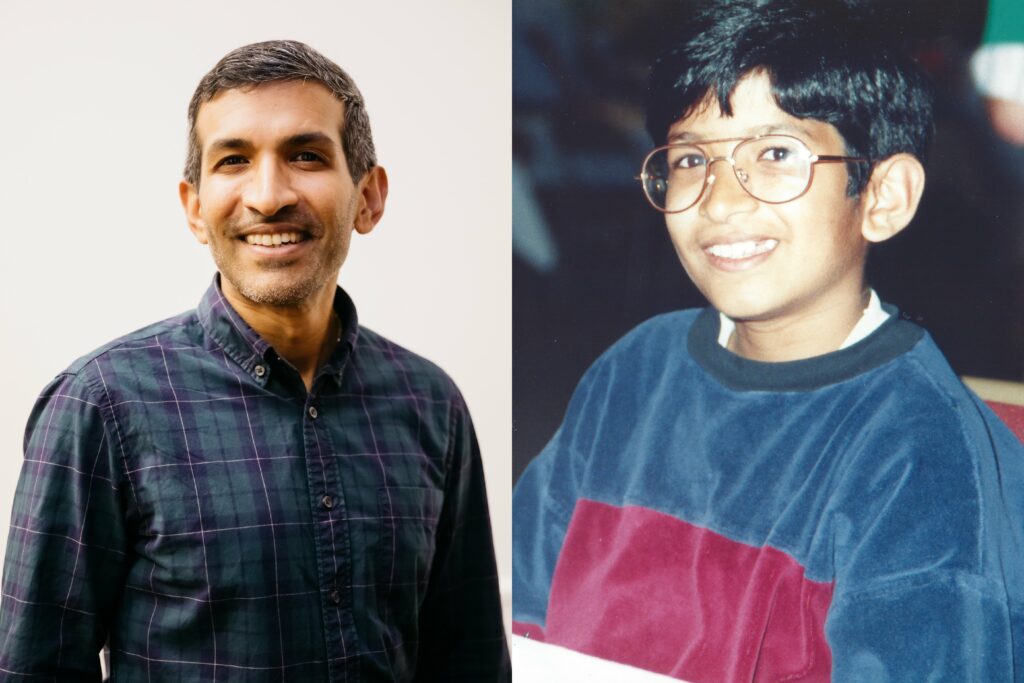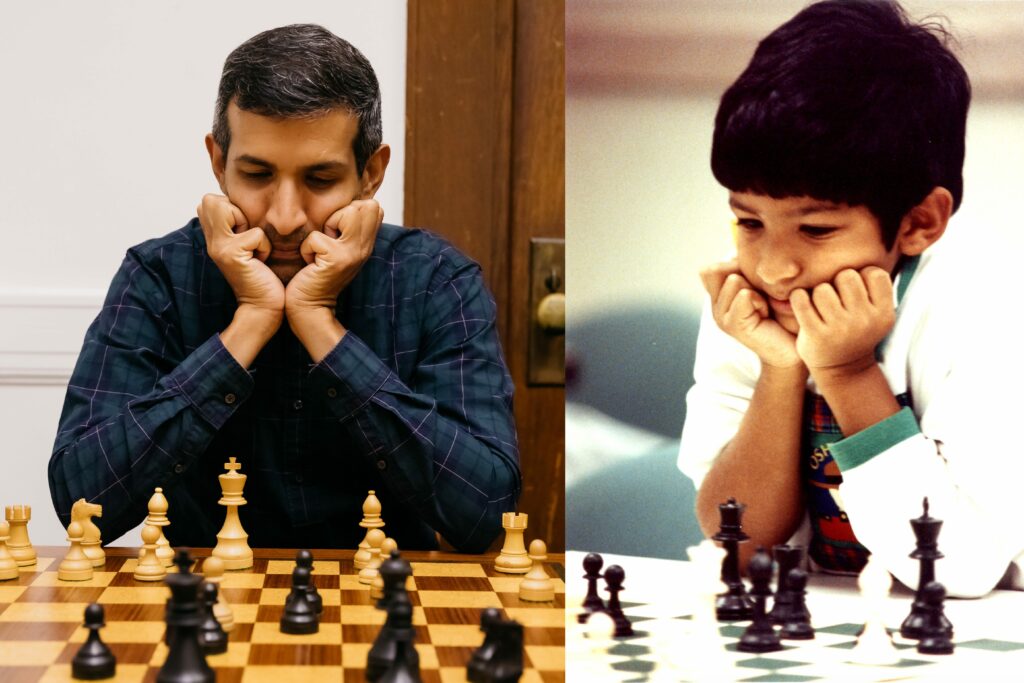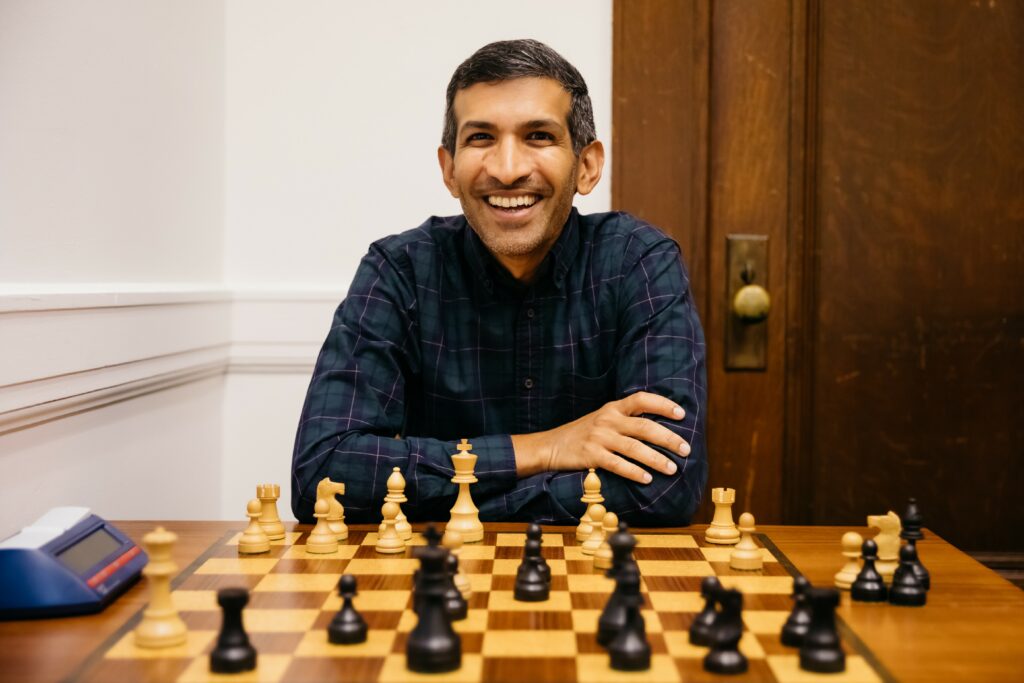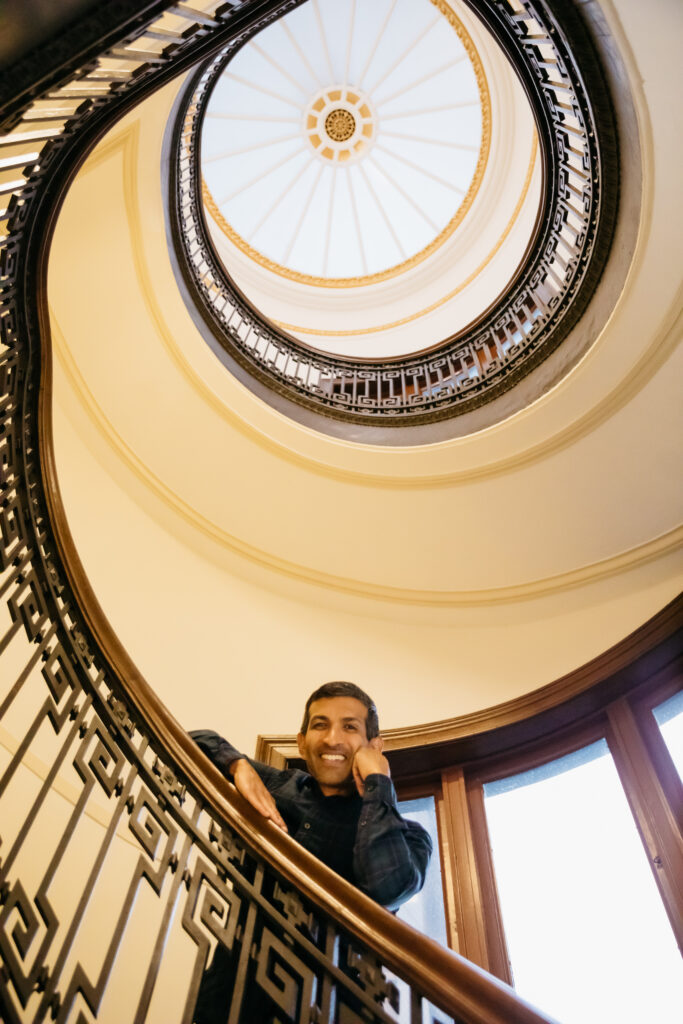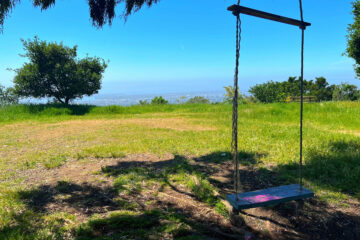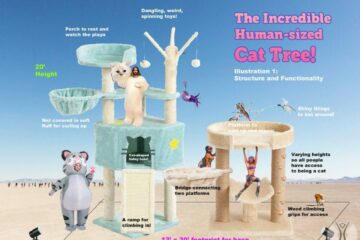Beyond the Board: Insights from a Local Chess Grandmaster
Growing up in San Jose, Chess Grandmaster Vinay Bhat achieved the distinction of becoming the youngest National Master at the age of ten. He currently has the esteemed title of Grandmaster, the second highest rank in chess (the top being World Champion which is given to the top player). Recently, Vinay wrote and published his first book, How I Became a Chess Grandmaster. During our interview, my aim was to delve into the correlations between learning chess and the valuable life lessons it can offer to anyone. We talk about family, life after a professional chess career and how the game of chess has helped Vinay look at life through a self-reflective lens.
How I Became a Chess Grandmaster provides a unique perspective as it’s part textbook and part biography. You see a window into the way that Vinay thought through many of his most challenging competitive games but also how he navigated this as a child. The opening chapter delves into his early chess journey, culminating in his remarkable achievement as the youngest national chess master at the tender age of 10. Subsequently, when he was 15 years, Vinay achieved the title of International Master, making him the youngest individual to do so in the history of the United States. What I love most about this book is that it shares the good moves, the bad moves and (most interestingly) how his career in chess helped him learn some valuable life lessons.
Vinay talks about his struggles and plateaus while he navigated the challenging landscape of chess during the 1990s and 2000s. He overcomes several plateaus, competitive hurdles, and the demands of academia and profession, Vinay ultimately claimed the pinnacle of chess expertise, the title of Grandmaster.
To have this type of dedication is truly special no matter what your sport is. Starting at the age of 6, Vinay has seemingly always had a love for chess. “I learned how to play around the age of 6½, when my mom taught me and my older brother. She had been taught by her dad while growing up in India, and while she liked chess, she had never played in a tournament. But once we showed some interest at home, she took us to the Kolty Chess Club in San Jose, and very quickly then, both my brother and I were hooked,” recalls Vinay.
Vinay’s Journey to Becoming a National Master at 10 started in Fremont:
Growing up, I remember kids going into different hobbies like football, cheerleading and even scouts. I never remember any of my friends getting into chess. Vinay’s parents supported his love of chess from a young age. They commuted to chess classes held in Fremont regularly which really solidified his love of chess. I love hearing from Vinay about his family’s support and encouragement at a young age. The book’s initial chapter beautifully captures how his mother nurtured his passion, illustrating her commitment to his pursuits. Heartwarming images depict his family’s presence at championships, including touching snapshots of Vinay resting on his parents’ laps as they eagerly await his turn. Family moments like these are some of the most tender and loving within the book. With support like that, of course you’d feel compelled to keep going.
“I grew up in San Jose, so I’m a Bay Area local! Back then (in the early 90s), there were lots of chess clubs in the Bay Area but they didn’t tend to offer beginner lessons. So even though we lived in San Jose, my mom drove us 30 minutes away to a class at the Fremont Public Library every Friday. That teacher, Richard Shorman, became a big influence on how I developed as a chess player. Nowadays, I think chess has become more popular and there are both more youth chess academies in the Bay Area but also tons of resources online,” says Vinay.
“I was really interested in chess myself, and while both my parents were very supportive, they also never put a lot of pressure on me. Their first priority was making sure I was doing well in school, and they also made sure I tried a bunch of other things. I tried AYSO soccer and the violin for a little bit, but didn’t like either that much; I loved playing baseball though, and I also liked playing tennis.
Both my mom and dad took me around to tournaments both locally, out of state, and abroad. One funny story about my mom is that while she had a driver’s license, she was hesitant to drive on the freeway in general. She preferred lower-speed city streets. But to get to the Fremont library class, we needed to take the highway, and she actually pushed through that fear to get us there!,” recalls Vinay.
How The Game of Chess Can Help You in Your Life Beyond The Board:
Ever since I was a kid, I’ve loved playing board games. I have memories of playing cards with my Grandma around the kitchen table in Montana. She’d somehow always win but I didn’t mind too much. Looking back, those precious moments helped me learn some valuable lessons around problem solving, teamwork and focus. Talking with Vinay, he talks a bit about some of the lessons he learned during his career in chess. Local Journalism for Working stiffs We write for the poets, busboys, and bartenders. We cover workers, not ‘tech’, not the shiny ‘forbes 100 bullshit’. We write about the business on your corner and the beer in your hand. Join the Bay's best newsletter.
“From a young age, I built up a habit of self reflection. In chess, you write down all the moves played, and so you can analyze your decision-making afterwards. Even though I don’t play anymore, I still journal regularly, which can be its own form of reflection.
In chess tournaments, you’re given a budget of time for a set of moves and if you run out of time you lose. So you have to decide how much time you’re willing to spend on any given move – knowing that there may be some complicated decision later you need to save time for. As a result, I have a ton of practice with time management under competitive pressure. Admittedly, most Grandmasters would say it was a relative weakness of mine compared to other GMs, but most people I’ve worked with seem to think I’m great at this! There are some other general skills that I think chess can help develop like patience, logical thinking, and focus, but those are less tangible to me,” says Vinay.
How Chess Unblocked Plateaus in Vinay’s Life and Chess Career
As Vinay said, in chess, you have to self-reflect a lot in order to learn and grow. If you want to get better, you need to analyze your own strategy and not allow yourself to get too down on yourself for too long. Progress is attainable, and your set objectives are within reach by evaluating the moves you’ve taken on your journey. If it sounds like skills that can be transferable, that’s because they are.
In Chapter 3 of Vinay’s book, chess takes a back seat. Instead, the chapter delves deeply into strategies for enhancing your skills and overcoming your vulnerabilities. So, I asked him point blank to tell us more about how some of these skills he learned playing chess can be leveraged to grow outside of the game. His answers were more than just a little inspiring to me.
“I got completely stuck 3 different times in my chess career for more than a year, and then had shorter periods of stagnation or burnout.
My first big realization about improvement in general was to recognize the value of working on my weaknesses as well as my strengths. For a while, I kept studying the same topics (that I was already strong in) and in the same way, and that had diminishing returns. You want to keep your strengths, but you need to improve on your weaknesses too in order to keep raising your overall level.
There was also a lot I didn’t know about chess, and it wasn’t always easy for me to discover that on my own. Sometimes getting a new perspective from a new teacher can help immensely.
Another unlock for me later was understanding my own motivations: why was I playing chess professionally? What excited me most about playing? What was I hoping to get from it? The way you learn and practice might change from when you’re doing something as a hobby to when it’s your profession. I also needed to align my reasons for playing chess (I love the game and I enjoy the competitive struggle, but I don’t need to win) with the competitive realities (I was playing professionally and winning tournaments was often the name of the game!).
Finally, one other common technique I used was to deliberately zoom out to try and find patterns behind my decisions. I tend to gravitate towards the details first and not see the forest for the trees. So I needed to take some time to go one level up from those details to connect the dots and see why I might be making certain mistakes before I could really make progress on them,” recalls Vinay.
In Vinay’s book, he goes play-by-play, sharing with the reader not only his moments of strength but also instances where he could have been a little more strategic. The book offers insights into his immediate strategies as well as the realizations he had, either in the moment or shortly thereafter. While the book occasionally serves as a textbook on achieving Grandmaster status, it also tells a life story that allows readers to relate to their own mistakes. It’s through Vinay’s reflection on his plays that his human side shines through.
In 2014, Vinay played against Magnas Carlson. At the time, Carlson was considered the top player in the world. He nearly won. In the book’s prologue, Vinay talks about what went wrong and when he knew he had lost the game.
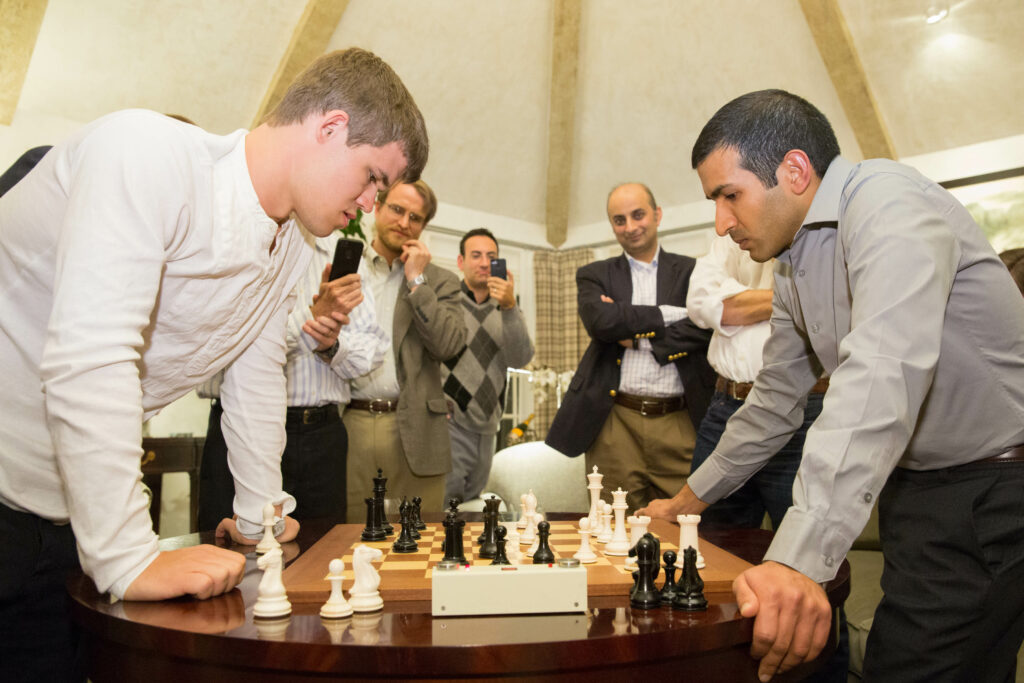
Vinay playing against Magnus Carlsen – current four-time World Rapid Chess Champion and current six-time World Blitz Chess Champion
Do you have to be a Prodigy to Become a Grandmaster?
Wouldn’t it just be awesome to be the best at something? I wanted to know, what does it really take to become a Grandmaster? Vinay’s answer to this inquiry was honest and had some surprises. Like how it’s not just about strategy but also you need to get a little creative and crafty at times, too.
“Chess definitely is some part science and so chess smarts plays a big role. But chess smarts don’t necessarily translate away from the chess board: at some point, more and more chess study really only helps your chess playing.
But chess also requires a lot of creativity. As other players can study your games, you can’t use the same idea twice and so to beat good players, you need to keep being able to create new problems for them.
Chess also requires a lot of discipline. The very top players train a lot to get there! And to be at the very top, like any sport, chess requires a lot of competitive desire. It’s not enough to be the most “chess book smart” chess player or simply the most “talented” chess player if your goal is to be to #1,” encourages Vinay.
What’s the best place to play chess in The Bay Area?
“My favorite spot has to be the Mechanics Institute Chess Room in San Francisco. It has a ton of history, a full library, and a dedicated chess room dating back to the 1800s. I only started to play there in the mid-to-late 90s, as they held more international-level events than anywhere else in the Bay Area. After becoming the youngest National Master in US history (at that time), I needed to play stronger opposition to continue to get better and I ended up completing my requirements for the International Master title at the Mechanics Institute.
Growing up, I played everywhere across the Bay Area – there used to be regular chess clubs in San Jose, Palo Alto, Burlingame, San Francisco, Berkeley, Walnut Creek, and Richmond for example. Most of those places have moved almost exclusively online now.”
Where can you meet Grandmaster Vinay Bhat in Person:
“I’ve done a few events in the Bay Area already, and my next two book events will be in Toronto (at the Hart House Chess Club at the University of Toronto) and New York City (at the Marshall Chess Club, another chess club dating back over a century). I’m hoping to do two more events in Menlo Park and Berkeley, but the dates are TBD,” says Vinay.
What is Vinay Up to These Days?
“I don’t play much at all anymore. I have only played one proper tournament in the past decade, and that was in 2014. I have played a couple blitz chess (5 minutes or less per player) and rapid chess (15 minutes per player) events over the past few years, and they have all been local events.
Outside of work, some of my main activities these days are playing tennis, reading, listening to music, and watching sports,” says Vinay.
When I asked who the book was for, Vinay was pretty clear that it’s not a book that is necessarily for a beginner. He mentioned to me that it’s actually intended for intermediate to expert level chess players. Which makes sense given by the end of Chapter 1, Vinay has won that coveted National Mater level. Sure, there may be better books for those who have never played chess before and there are definitely some terms which went a little over my beginner’s head. However, I’d argue that this book teaches us life lessons which are transferable and help us see how the game of chess can also help us in so many other ways. The book emphasizes the importance of family support, encouraging self-reflection for improvement, and harnessing skills learned in chess for personal growth beyond the board.
Vinay Bhat no longer engages in extensive play, yet he remains an avid follower of the chess scene. One of his former chess students, Sam Shankland, has risen to become one of the world’s leading players. Vinay is also closely monitoring a remarkable group of teenagers hailing from Iran, India, Uzbekistan, and Germany. He acknowledges their exceptional strength and admits that they surpass his own skills in their impressive prowess.
I do hope you’ve enjoyed getting to know Vinay Bhat through this interview and article about his achievements and his new book. This year, I’m working hard to highlight how amazing the community of people is within the Bay Area. From outstanding chefs to local chess legends, we’re lucky to be able to learn and grow from the people around us every day. Send us some of your local heroes. We’d love to get to know them more and feature them within Broke-Ass Stuart.
Where can you find Vinay Bhat online?
VINAY’S BOOK “HOW I BECAME A CHESS GRANDMASTER”
Facebook: https://www.facebook.com/vbhat
Wiki: To learn all about Vinay’s Chess Career
IG: @vsbhat02
Twitter: @vsbhat02
Get to know Vinay Bhat more via this interview of him talking About His Book: “How I Became a Chess Grandmaster”
all images are from Vinay Bhat – portraits are by Vita Hewitt

Howdy! My name is Katy Atchison and I'm an Associate Editor for Broke-Ass Stuart.
I want to take the time to say thank you for supporting independent news media by reading BrokeAssstuart.com. Supporting independent news sources like Broke-Ass Stuart is vital to supporting our community because it amplifies the voices of a wide variety of diverse opinions. You also help support small businesses and local artists by sharing stories from Broke-Ass Stuart.
Because you're one of our supporters, I wanted to send over a pro-tip.
Our bi-weekly newsletter is a great way to get round ups of Broke-Ass Stuart stories, learn about new businesses in The Bay Area, find out about fun local events and be first in line for giveaways.
If you’d like to get our newsletter, signup right here, it takes 5 seconds.



